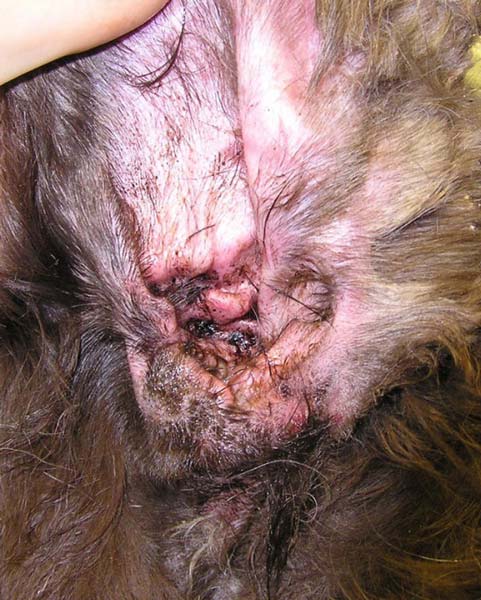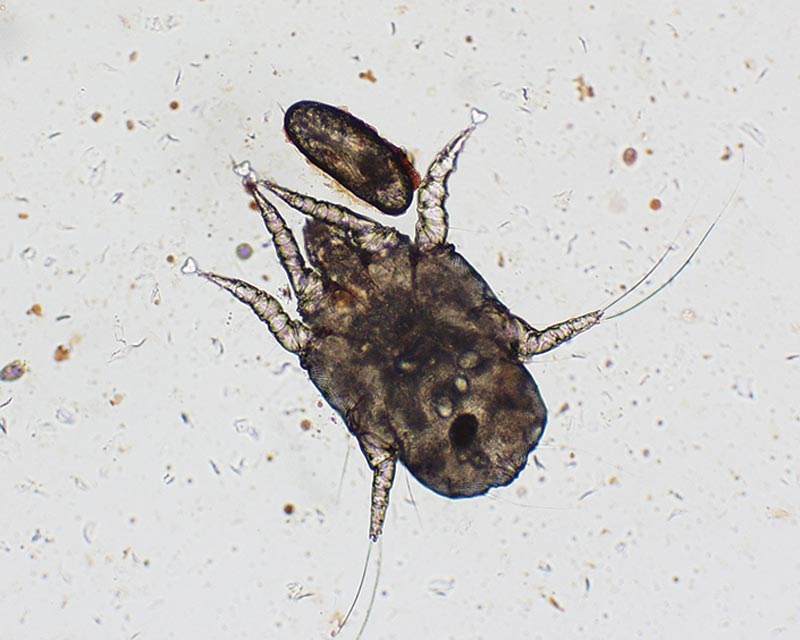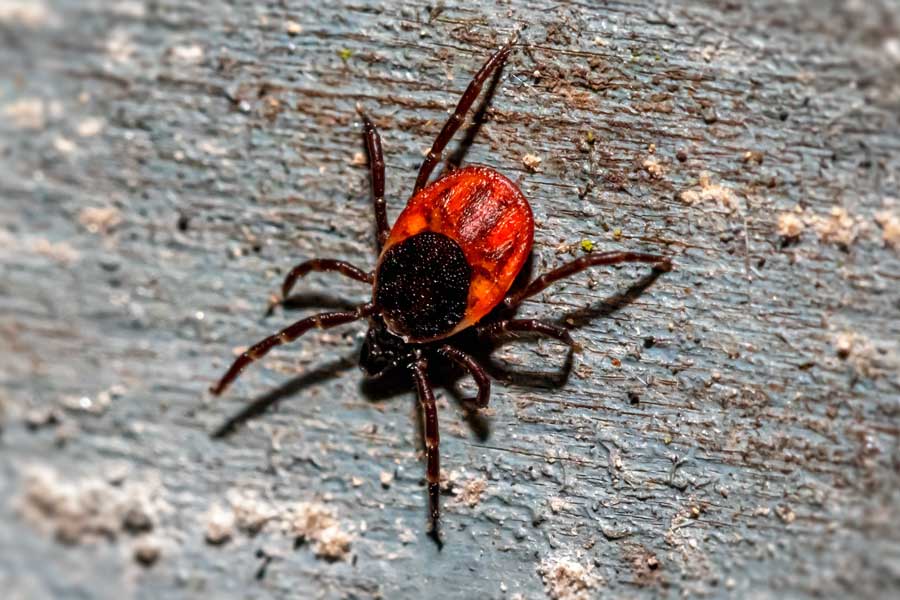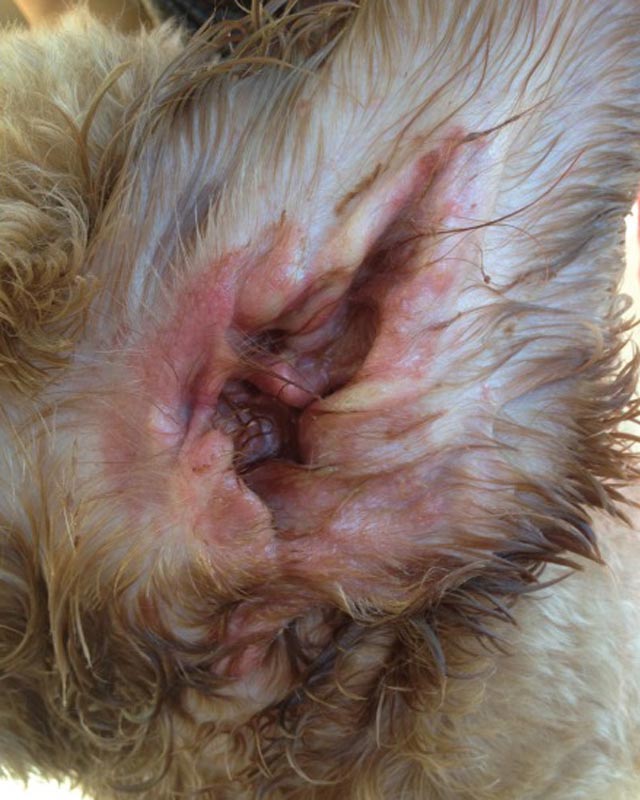How Ear-ritating: Itchy Ears + Otic Infections in Dogs
Remember, this is an educational resource, not a guide for diagnosis.
Pictures are helpful, but they may not tell the whole dermatological story. We always recommend consulting with your vet for any of your dog's health concerns.
🎄 25% Off 🎄 Christmas Countdown Sale
Use code FELIZNAUGHTYDOG at checkout and get your dog, grand-dog, or your friend's dog the gift of relief!
Why Are My Dog's Ears Itchy?
Dog ears are a sound location for an itch to happen, especially in breeds with ears that droop, fold, or have long hair in their ear canals. If you see your dog constantly digging in their ears, shaking their head, whining, or holding their head tilted to the side, you'll want to investigate.
There are a variety of reasons behind itchy ears, and many of them tend to overlap. As dogs scratch, they can damage the skin of the ear canal and more complicated issues can arise - after all, scratching your ears with your feet isn't exactly a precise science.

Allergies
Allergies are first among the top causes of itchy dog ears. Environmental allergens, such as grass, pollen, and dust, along with food allergies, trigger an irritating skin reaction, called atopic dermatitis, or atopy.
Allergies often contribute to ear infections. The skin of the ears becomes red, warm, and inflamed, and creates an excellent place for opportunistic microbes to grow. Chronic ear infections can be a sign that your dog has a sensitivity to a particular allergen or substance.
What foods are dogs typically allergic to?
Certain proteins are the most common food ingredients identified with canine food allergies. In order of commonality, they are beef (by a large margin), then dairy, chicken, wheat, and lamb. Other allergens that are far less common across dogs are soy, corn, pork, egg, fish, and rice. See our Complete Guide to Food Allergies in Dogs for much more on this.

Bacterial or Yeast Infections
Small colonies of bacteria and fungi naturally dwell on your dog's skin, including in the ears. These microbes thrive in dark, warm, and moist environments, and an infection occurs when these microbe populations grow out of control.
Bacteria and fungi also love damaged or broken skin, which typically occurs when dogs repetitively scratch at an itch. It is possible for dogs to have both a bacterial and yeast infection at the same time.
Most canine bacterial skin infections (aka pyoderma) are caused by a species of Staphylococcus called Staph pseudintermedius and another bacteria called Pseudomonas aeruginosa. Both of these bacterial species can form biofilms, which resist antimicrobial treatments and make the infection much harder to eliminate.
Most fungal (yeast) infections are caused by a species of yeast known as Malassezia pachydermatitis. As a quick plug: Lavengel® can be very helpful against both types of microbes, their infections, and even the bacterial biofilms, according to our research.
A Heads Up for Dogs That Love Water
Water in the ears helps create a great Petri dish for microbes to grow in. Dogs that spend a lot of time in the water are more prone to get ear infections, so be sure to gently dry their ears with a cotton ball or soft cloth after swimming.
Yeast infection in dog ear; photo via the Cornerstone Animal Clinic of Dallas.
Symptoms of Canine Ear Infections (Otitis Externa)
- Constantly scratching ears, shaking head, rubbing head on things, tilting their head
- Head shyness (avoids being pet on the head)
- Red, inflamed ear canals
- Swollen ear tissue or thickened ear flap
- Pain and sensitive ears
- Dark yellow or brown ear discharge with bad odor
- Depression and irritability
It's very important to note that ear infections have different causes, and simple assumption can lead to extra frustration and expense. Thus, it is vital to perform a cytology to identify the specific microbe(s) behind the infection, select the appropriate treatments or medications, and evaluate response to treatment.

Foreign Objects or Debris
Sometimes things get stuck in a dog's ear, and they're simply trying to get it out. Loose straw, grass clippings, dirt, bits of mulch, and seeds such as burrs and foxtails can get caught in those listening flaps.
If your dog has long ear hair or a significant amount of inner ear hair, be sure to check their ears for "treasure" that they may have picked up while romping around outside. Use caution if they are in pain, or even consider having a vet help with the extraction.
Wax Buildup or Trapped, Matted Hair
Ears need proper air flow to stay dry and minimize the microbial growth. An accumulation of too much ear wax can create an irritation and pressure in the ear.
Dogs with long ear hair or lots of inner ear hair - spaniels, poodles, Shih tzus, Yorkshire terriers, and others - run the risk of their hair becoming matted and forming knots. These can also be annoying for dogs and call for a vigorous foot-in-ear session.

Ear Wound or Injury
Wounds can be causes for irritated ears. Rough play with other dogs, accidents, foxtail seeds, or excessive scratching or head shaking can injure or damage the skin of the ear.
Blood- or fluid-filled spots referred to as aural hematomas can develop as a result of trauma. As we mentioned before, bacteria and yeast are always seeking an opportunity to grow, and open wounds are prime locations to establish an infection.
If you notice a wound in or on your dog's ear - or anywhere else on your dog, really - clean the area and apply some Lavengel®. It will not only relieve the discomfort, but also protect the wound from microbes and help it heal faster.
For more handy-dandy first aid tips and how to build your own dog first aid kit, check out our Canine First Aid page.
Ear Tumors or Polyps
A tumor is an overgrowth of cells in an abnormal place, and a polyp is a variation of a small tumor. Ear polyps typically come in two forms: ceruminous gland adenomas, coming from the glands that make wax (generally benign), and squamous cell carcinomas, arising from the cells lining the ear canal (more aggressive).
It is not fully understood why ear polyps develop, but chronic inflammation in the ear canal can lead to their development. While these growths may not be inherently itchy, they can hamper the function of the ear and lead to a buildup of wax and infections. Surgical removal is generally the most effective way to treat ear polyps.

Ear Mites
Ear mites are tiny, microscopic parasites that live in the ear canal of many animals, and travel from host to host via physical contact. The species that typically affects dogs and cats is called Otodectes cynotis; demodectic mange mites may also target ears on occasion.
Ear mites feed on skin oils and ear wax, and an infestation often generates an itchy infection that leaves a dry black/brown discharge similar to coffee grounds. However, it should be noted that residue like this is classic among ear infections and is not exclusive to ear mites.
Determining the presence of ear mites calls for a trip to the vet, where they will take a sample to be examined under the microscope (a process called cytology). Treatment for ear mites will generally involve prescription topicals or oral meds with active ingredients such as selamectin, moxidectin, saralaner, and fluralaner. Some prescription flea and tick preventatives are also effective in preventing ear mites.
Photo: Otodectes cynotis mite, by Barbie Papajeski, MS, LVT, RLATG, VTS; via Today's Veterinary Nurse

Ticks and Fleas
It's no secret that fleas and ticks love a concealed place to hide when they make a meal out of your dog, and the ears are a great place for it. Ticks tend to be more likely to hide under the ears than fleas, but both are possible and quite itchy.
If your dog spends time outdoors, it's always a good idea to check for ticks and keep them on a flea and tick preventative. If you find them, you can remove them (if you're feeling brave) with your fingers or with a pair of plastic tweezers. Either way, you'll want to be sure to remove their head when you extract them.
For more on ticks and a list of the best vet-recommended flea and tick prevention products on the market, see our Dog Tick Tips and Prevention post.
Breeds Commonly Affected by Ear Infections
All dog breeds can suffer from ear (otic) infections, but there are certain traits that make some breeds more susceptible than others.
For example, breeds that are brachycephalic (flat-faced) have narrow ear canals that easily trap moisture and do not allow for good air circulation. In the same vein, breeds with long ears or long hair in the ear canals can accumulate debris and wax and likewise trap moisture and have restricted air flow.
As mentioned previously, dogs that spend a lot of time swimming or undergo frequent bathing run a higher risk of contracting an ear infection.

How Are Dog Ear Infections Treated?
After an examination with an otoscope (the fancy ear magnifying glass) and cytology (taking samples + examining under a microscope), your vet will determine what microbe(s) are causing the infection. Compound infections - more than one microbe - are a possibility.
Treatment for otic bacterial (pyoderma) and yeast (Malassezia) infections generally begin by cleaning the ears to remove cerumen (wax), debris, or discharge. From there, topical medications are the standard, along with anti-inflammatory meds to help with pain and swelling.
For severe or chronic cases of ear infections, systemic oral medications may be required. While these medications can be effective, they call for prolonged use to eradicate the infection(s), which can put stress on the liver. Not only that, bacteria have the ability - especially if they've developed a biofilm - to resist systemic medications and "share" their resistance mechanisms with other bacteria.
An alternative to prescription topicals that can make a difference with both relieving irritation and helping to reduce inflammation and microbial burden (including biofilms) is Lavengel®. It's made with safe, pronounceable ingredients and backed by 14+ years of microbiology research.
Photo by Dr. Jangi Bajwa, via the Canadian Veterinary Journal

Ear Infection Prevention
We always recommend seeking veterinary attention if your dog has an ear infection, especially since there could be other infection or complications present.
A few ways you can help prevent your dog from developing an ear infection are:
- Clean their ears every week or two
- Keep water out of their ear canals when bathing
- Make sure their ears are dry after bathing or being in water
- Trimming hair in the ear canal (for dogs with long hair in the ear canal)
- Make note of their allergies or allergic skin reactions. For example: Do they tend to be more itchy in the spring/fall? Did they have a reaction to a new food?
- Feeding them a healthy, well-balanced diet and being aware of food allergies, which have been linked to chronic cases
- Routine vet visits and scheduling appointments quickly when a problem arises
- Keep some Lavengel® on hand!
Super Soothing Skin + Wound Salve for Dogs
Sale Price with Code: $14.25
Lavengel® is a powerful, soothing cream that quickly relieves irritated skin affected by hotspots, wounds, rashes, itchy ears, infections, bug bites, sores + more.
25% off! Code FELIZNAUGHTYDOG
Free standard shipping on orders over $35
30-day money back guarantee
For every unit sold, we donate to help dogs + heroes








More Common Canine Skin Issues
-

Atopic + Allergy Dermatitis
Atopic worth exploringSkin allergies bring an incredible amount of itching, scratching, and complications. Learn their causes and what to do about them.
-

Excessive Paw Licking
Paws and considerSo why do dogs lick their paws so much? There are actually several reasons (some can even overlap), which we address - with photos!
-

Yeast Infections
This yeast is liked leastYeast infections affect the skin (dermatitis), ears (otitis), paws, and nails - all caused by a microscopic fungus called Malassezia.
Collapsible content
Resources on itchy ears, otitis + more
- UrgentVet: Why Is My Pet Scratching Their Ears?
- Veterinary Skin & Ear: Food Allergies in Dogs
- Cornerstone Animal Clinic of Dallas: Ear Infections in Dogs
- Fletcher Vet: Itchy Ear Management
- Oakland Veterinary Referral Services: Ear Polyps in Pets
- Mar Vista Animal Medical Center: Ear Mites
- Today's Veterinary Nurse: Ear Cytology: Sampling, Processing, and Microscopic Evaluation
- Canadian Veterinary Journal: Canine Otitis Externa - Treatment and Complications



